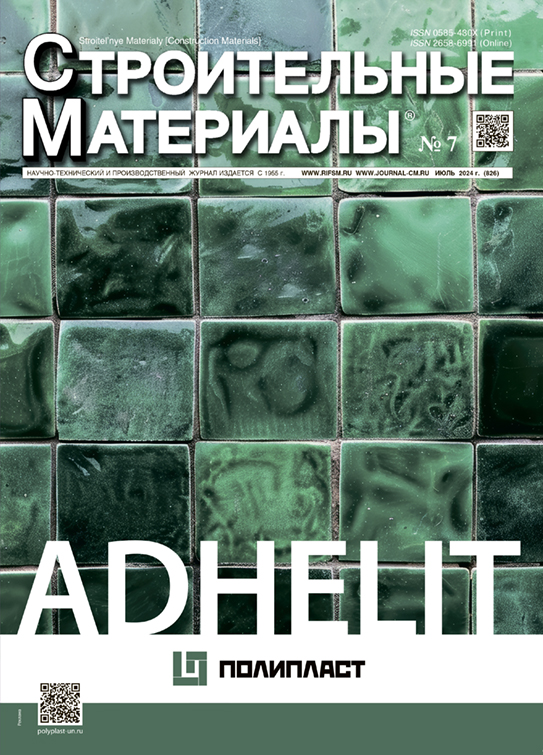Lightweight Concretes on Hollow and Porous Aggregates
- Autores: Inozemtsev A.S.1, Korolev E.V.2
-
Afiliações:
- National Research Moscow State University of Civil Engineering
- Saint Petersburg State University of Architecture and Civil Engineering
- Edição: Nº 7 (2024)
- Páginas: 41-47
- Seção: Modern concretes
- URL: https://freezetech.ru/0585-430X/article/view/635044
- DOI: https://doi.org/10.31659/0585-430X-2024-826-7-41-47
- ID: 635044
Citar
Texto integral
Resumo
One of the directions of development of concrete science is the combination of positive qualities of heavy and lightweight concretes. The problem of optimizing the structural properties of heavy concrete and the thermal properties of lightweight concrete is solved in a large number of scientific papers. In Russia, the most popular structural lightweight concretes are those based on expanded clay aggregate. Recently, there has been experience in reconstructing bridges made of lightweight concrete on hollow microspheres. Over the past 10 years, the possibilities for producing lightweight concrete with increased strength have improved significantly. The paper presents models demonstrating the features of the formation of the structure of lightweight concrete on hollow and porous aggregates. The advantages and limitations are described for each of the aggregates for obtaining lightweight concrete with a given average density and strength. The described models show that it is advisable to use porous filler to obtain high-strength lightweight concrete with an average density of more than 1600 kg/m3, and hollow filler at ρlb<1600 kg/m3. The thickness of the filler shell becomes the determining factor in achieving the required specific strength of lightweight concrete.
Palavras-chave
Texto integral
Sobre autores
A. Inozemtsev
National Research Moscow State University of Civil Engineering
Autor responsável pela correspondência
Email: InozemcevAS@mgsu.ru
Candidate of Sciences (Engineering)
Rússia, MoscowE. Korolev
Saint Petersburg State University of Architecture and Civil Engineering
Email: korolev@nocnt.ru
Doctor of Sciences (Engineering)
Rússia, Saint PetersburgBibliografia
- Popov N.A. Proektirovanie legkobetonnykh monolitnykh sten [Design of lightweight concrete monolithic walls]. Moscow: Gosstroyizdat. 1933. 210 p.
- Popov N.A. Novye vidy legkikh betonov [New types of lightweight concrete]. Moscow: Gosstroyizdat.1939. 196 p.
- Simonov M.Z. Beton i zhelezobeton na poristykh zapolnitelyakh [Concrete and reinforced concrete on porous aggregates]. Moscow: GILSIA. 1955. 256 p.
- Strongin N.S., Baulin D.K. Legkobetonnye konstruktsii krupnopanel’nykh zhilykh domov [Lightweight concrete structures of large-panel residential buildings]. Moscow: Stroyizdat. 1984. 184 p.
- Yakubovich M.A. Avtodorozhnye mosty iz legkogo zhelezobetona [Lightweight reinforced concrete road bridges]. Moscow: Autotransizdat. 1956. 68 p.
- Meshkauskas Yu.I. Konstruktivnyi keramzitobeton [Structural expanded clay concrete]. Moscow: Stroyizdat. 1977. 87 p.
- Baulin D.K. Mezhduetazhnye perekrytiya iz legkikh betonov [Interfloor slabs made of lightweight concrete]. Moscow: Stroyizdat. 1974. 216 p.
- Gorin V.M., Shiyanov L.P. Expanded clay and expanded clay concrete in housing construction and public utilities. Stroitel’nye Materialy [Construction Materials]. 2007. No. 10, pp. 98–100. (In Russian).
- Rossignolo J.A., Agnesini M.V.C., Morais J.A. Properties of high-performance LWAC for precast structures with Brazilian lightweight aggregates. Cement and Concrete Composites. 2003. Vol. 25. Iss. 1, pp. 77–82. https://doi.org/10.1016/S0958-9465(01)00046-4
- Patent RF 2355656. Betonnaya smes’ [Concrete mix]. Ponomarev A.N., Yudovich M.I. Declared 10.05.2007. Published 20.05.2009. (In Russian).
- Figovsky O.L., Beilin D.A., Ponomarev A.N. Successes in the application of nanotechnology in construction. Nanotechnology v stroitel’stve [Nanotechnology in construction]. 2012. Vol. 4. No. 3, pp. 6–22. (In Russian).
- Bazhenov Yu.M. Tekhnologiya betona [Concrete technology]. Moscow: ASV. 2015. 528 p.
- Zhang M.H., Gjorv O.E. Permeability of high-strength lightweight concrete. ACI Materials Journal. 1991. Vol. 88 (5), pp. 463–469. doi: 10.14359/2108
- Falikman V.R., Sorokin Yu.V., Goryachev O.M. High-strength lightweight concrete: technology and properties. Beton i zhelezobeton. 2005. No. 2, pp. 8–11. (In Russian).
- Nadesan Manu S., Dinakar P. Mechanical properties of sintered fly ash light weight aggregate concrete. 14th NCB International Seminar on Cement and Building Materials. 2015. https://doi.org/10.1016/j.matpr.2023.05.511
- Nadesan M.S., Dinakar P. Structural concrete using sintered flyash lightweight aggregate: A review. Construction and Building Materials. 2017. Vol. 154, pp. 928–944. https://doi.org/10.1016/j.conbuildmat.2017.08.005
- Cerny V., Kocianova M., Drochytka R. Possibilities of lightweight high strength concrete production from sintered fly ash aggregate. Proccedia Engineering. 2017. Vol. 195, pp. 9–16. https://doi.org/10.1016/j.proeng.2017.04.517
- Mehta P.K., Monteiro P.J.M. Concrete: microstructure, properties, and materials. New York: McGraw-Hill. 2006. pp. 1–7.
- Inozemtsev A.S., Korolev E.V. High-strength lightweight concretes [Vysokoprochnye legkie betony]. Saint Petersburg: SPbGASU. 2022. 192 p.
- Makridin N.I., Maksimova I.N. Artificial porous fillers and lightweight concrete [Iskusstvennye poristye zapolniteli i legkie betony]. Penza: PSUAS. 2013. 324 p.
- Petrov V.P., Makridin N.I., Yarmakovsky V.N. Poristye zapolniteli i legkie betony. Materialovedenie. Tekhnologiya proizvodstva [Porous fillers and lightweight concrete. Materials Science. Production technology]. Samara: SGASU, ASV. 2009. 436 p.
- Birger I.A., Shorr B.F., Iosilevich G.B. Raschet na prochnost’ detalei mashin [Strength calculation of machine parts]. Moscow: Mechanical engineering. 1993. 640 p.
- Bobryshev A.N., Erofeev V.T., Zharin D.E. Osnovy formirovaniya struktury kompozitsionnykh materialov [Fundamentals of formation of the structure of composite materials]. Saransk: Moscow State University named after N.P. Ogarev. 2012. 120 p.
Arquivos suplementares















